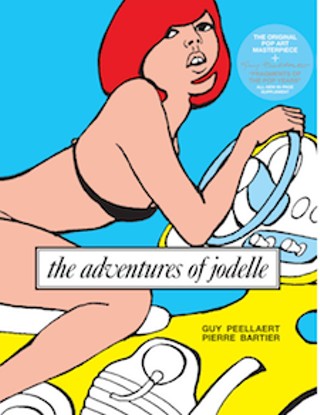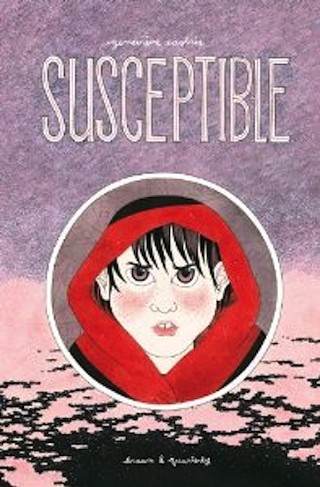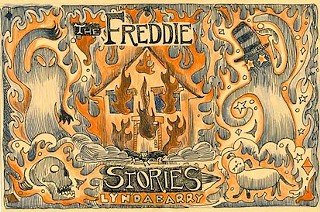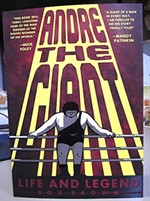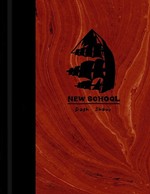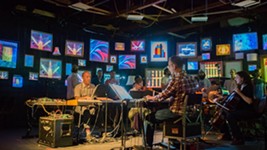Drawn and Quarterly? Fantagraphics? A Few Recent Releases?
Yes: Our new comics-reviewing team gives 'em a look-see
By Wayne Alan Brenner, Shannon McCormick, and Erika May McNichol, 3:34PM, Fri. May 10, 2013
Lot of amazing comic books and graphic novels and compilations of sequential art – or whatever label you wanna tag the stuff with – coming out lately.
But, yeah, that statement isn't news and hasn't been news for at least a decade now. But so here, about damned time, here are reviews of three recently published works, offered by your regular comics-reviewing guy (Brenner) and two new guest reviewers (Shannon McCormick and Erika May McNichol). We'll be covering new book releases a bit more frequently than in the past, is the idea here – especially new stuff from the indie-publishing neighborhoods of comicsville – and are feeling pretty stoked that McCormick and McNichol will be part of the reviewing team.
Or maybe not team.
Maybe, like, cadre or cohort instead.
Sounds just a bit cooler, right?
Although, cohort, that has some precise definition from back in Roman times, doesn't it?
Anyway: You can look forward to more regular recommendations and critiques and considerations of what's available in the rapidly embiggening world of comics these days.
(You what? You publish a few comics yourself? Cool: Send 'em to the Chronicle in care of that Brenner – P. O. Box 49066, Austin, Texas, 78765 – and we'll add them to the gotta-check-this-out stacks.)
For right now, here's a triple scoop of assessment of three big releases:
The Freddie Stories by Lynda Barry
Drawn and Quarterly; hardcover, 72pp; $19.95
www.drawnandquarterly.com
Do you remember your childhood? At least enough to render it, with all its intricate personal details, as a series of comic strips? Lynda Barry does. That is, she remembers her own childhood, or at least she renders it or a fictionalized version of it (and that of siblings and friends) so vividly, with so many intricate personal (poignant, embarrassing, gnarly, seemingly crazed but perfectly logical at the time) details, as a series of comic strips –
(Perfectly logical at the time? Like when you did that thing with the ants and the cookie crumbs and the garden hose because you'd just seen a movie about General Patton and because Operation: Patton Ants was also less risky, paternal-beltwise, than setting your sister's remaining Barbie on fire?)
– as a series of comic strips that capture the core of being that age, at that time, in those circumstances.
She renders it in such a precise way that it hurts.
("Circumstances," yeah. In the Roast Beef Kazenzakis sense of the word.)
These are The Freddie Stories that Barry conjured for her altweekly-disseminated Ernie Pook's Comeek back in the '90s, presenting "a year in the life of the youngest member of a troubled, often dysfunctional family." Yes, dysfunctional – in a manner unknown to the rumored happy families that are all alike, with the youngest family member here, Freddie, AKA Skreddy 57, helplessly alive with funk and fantasy and terror and sorrow, galvanized (in that electrical-wire-in-a-dead-frog's-leg-muscle way) by the sheer immensity of existence and the relentless array of facts it offers for cataloguing, almost failing to survive the repressive and bully-bludgeoned journey to adolescence. These strips, along with many left out of the collection's earlier iteration, are offered in a beautifully made hardcover edition from Drawn & Quarterly. And, note: Even these strictly black-and-white scratchings of Barry's skilled and lyrical pen are presented against lined fields of color.
"When you look into an abyss, the abyss also looks into you." Good old Freddie Nietzsche said that in another context, but he could've been talking about this presentation of a sort of larval abyss that can be as harrowing as the adult phase some of us carefully avert our gazes from. We recommend you look into this one from Barry and D&Q, see if your mouth isn't occasionally (maybe nervously) laughing while your memory-haunted heart breaks over and over and over.
– Wayne Alan Brenner
The Adventures of Jodelle by Guy Peellaert and Pierre Bartier
Fantagraphics; hardcover, 164pp; $45
www.fantagraphics.com
Make no mistake, this thing is a fetish object in a couple of senses. First, let’s start with the book itself – Christ, this thing is gorgeous. Large format, rich color printing, and numerous insert-laden essay pages in the back detailing Guy Peellaert’s copious career outside of comics – he’s probably best known to the visually minded as the creator of the cover of David Bowie’s Diamond Dogs and the poster of Martin Scorsese’s Taxi Driver. Then there's the content of the comic itself, a swinging Sixties mod jam with art by the Belgian Peellaert and scripted by Pierre Bartier (who? oh yeah, just some 19-at-the-time French goofball, whatevs, Peellaert’s the main attraction here), a scantily clad mashup of spy thrillers and sword-and-sandal movies, with the titular Jodelle, a spitting image for yé-yé singer and teen heartthrob Sylvie Vartan, in eyebrow-raising undress throughout.
Like his American Pop Art idols and comrades, Peellaert’s work smashed distinctions between "high" and ‘low’ modes of art, drawing from the visual language of advertising, cinema, fashion, and youth culture, as well as classical and neo-classical sculpture and architecture. Hell, one of the avowed primary visual influences on Jodelle was the Gottlieb pinball machines Peellaert played as a teen in post-War Brussels. As with other European experimental pop works of the time – Godard’s Contempt or Dino Buzzati’s Poem Strip, for instance – the work is steeped in the deep waters of European history. But Jodelle is much more exuberant than those works, A Hard Day’s Night as opposed to the thornier contemporaneous works of a Godard or Melville. Jodelle is set in an anachronistic first-century Rome where scooters and convertibles and gats and phones coexist with swords and centurion armor. The setting always feels as informed by Las Vegas’ version of European antiquity as it is by the real thing, and it’s all the livelier for it.
So, OK, here’s the deal – the art sings, but alas in a kind dated way; even if you know nothing about comics you could spot this as something from the Sixties from 30 yards away. The plot of the spy caper is paper-thin. The sexual thrills probably felt liberating and quasi-revolutionary at the time, but are nevertheless thick with the stale must and musk of the male gaze. And, considering the hefty price tag, I found myself wondering: Just who is this book for? There’s no denying the historical importance of Jodelle, viewed by many as one of the first graphic novels. The first American edition was put out by Grove Press – sort of the McSweeney’s of its day – in the States in the '60s rather than by a traditional comics publisher. But the lines between "high" and "low" have long been obliterated, and a 15-minute spin on Tumblr would give any young cartoonist as much disparate visual fodder as Peellaert would have gotten in his entire youth in the Brussels underground with its American jukeboxes and pinball machines.
As with many of Fantagraphics' beautifully crafted historical reissues, the result is as much expensive funerary monument to a time dead and gone as it is a thing that hungry young artists will get grubby with and be influenced by. And hey, tombstones are as much a part of visual culture as fashion magazines and music videos. I guess weirdo kids still like hanging out in graveyards, but in the end I suspect this edition is really for their better-heeled middle-aged brethren with book (and other kinds of) lust still in their hearts.
– Shannon McCormick
Susceptible by Geneviève Castrée
Drawn and Quarterly; hardcover, 80pp; $19.95
www.drawnandquarterly.com
Geneviève Castrée recounts her upbringing in Quebec, in the autobiographical, coming-of-age piece, Susceptible.
Goglu is the unplanned outcome of young love and a summer romance in Alberta, and details her childhood and adolescence with, mostly, her mother, who flounders with the basics of parenting. A likable but disengaged father, 5000 miles away in Vancouver, serves as a constant spectre in Goglu’s life; many of the sequences where her mother has overlooked or neglected some critical aspect of raising a child (such as getting shit-faced at a New Year’s party with Goglu along, or leaving her to get ready and take herself to school at a young age, or getting shit-faced in front of Goglu’s friends) emphasize his absence. More than a few recollections in Castrée’s book evoked an uncomfortable feeling, like the times you end up with front-row seats to the spontaneous argument between your best friend’s parents. When Goglu’s mother gets stoned and corners her in the basement – despite Goglu’s attempts to avoid her -- you can almost smell her dry mouth and stale breath as she tries to assuage her own insecurities with her daughter.
The self-taught artist renders her story through lovingly executed panels and an interesting narrative, but the book left me feeling empty. Castrée seems to write the book as an exercise in self-reflection, but I struggled to make the jump to connecting with the larger theme of nature vs. nurture. Is Goglu railroaded into the life that her mother lives: irresponsible, self-absorbed and complicit in her lack of forward movement? Castrée seems to point to yes, that she indeed is, in the opening sequence of the book, but leaves this open at the book’s close.
Susceptible was an uncomfortable and emotionally unsatisfying book, personally, but perhaps that’s the point. Castrée translates many of the recollections from her native tongue into English, which left me wondering if something was simply lost in translation. In all, Susceptible was a nice way to mark an evening, but failed to the deliver the lasting ruminations on its content the way other autobiographical works in this medium have.
– Erika May McNichol
A note to readers: Bold and uncensored, The Austin Chronicle has been Austin’s independent news source for over 40 years, expressing the community’s political and environmental concerns and supporting its active cultural scene. Now more than ever, we need your support to continue supplying Austin with independent, free press. If real news is important to you, please consider making a donation of $5, $10 or whatever you can afford, to help keep our journalism on stands.
March 22, 2024
March 22, 2024
May 6, 2014
Sept. 2, 2013
Sept. 2, 2013
graphic novels, comic books, Fantagraphics, Drawn and Quarterly, Lynda Barry, Guy Peelaert, Genevieve Castree, Shannon McCormick, Erika McNichol May, Jodelle, Susceptible, Skreddy 57, better-heeled middle-aged brethren





